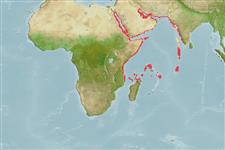Preferred temperature (Ref.
123201): 24.8 - 29.2, mean 27.1 °C (based on 222 cells).
Phylogenetic diversity index (Ref.
82804): PD
50 = 0.5078 [Uniqueness, from 0.5 = low to 2.0 = high].
Bayesian length-weight: a=0.02344 (0.01098 - 0.05004), b=2.97 (2.80 - 3.14), in cm total length, based on LWR estimates for this (Sub)family-body shape (Ref.
93245).
Nivel trófico (Ref.
69278): 2.0 ±0.00 se; based on food items.
Resiliencia (Ref.
120179): Medio, población duplicada en un tiempo mínimo de 1.4-4.4 años (Preliminary K or Fecundity.).
Fishing Vulnerability (Ref.
59153): Low to moderate vulnerability (27 of 100).
Nutrients (Ref.
124155): Calcium = 36.8 [16.7, 111.9] mg/100g; Iron = 0.784 [0.286, 1.806] mg/100g; Protein = 18.2 [16.9, 19.5] %; Omega3 = 0.126 [0.061, 0.262] g/100g; Selenium = 12.3 [4.3, 42.2] μg/100g; VitaminA = 39.1 [9.1, 154.5] μg/100g; Zinc = 1.83 [0.83, 3.28] mg/100g (wet weight);
